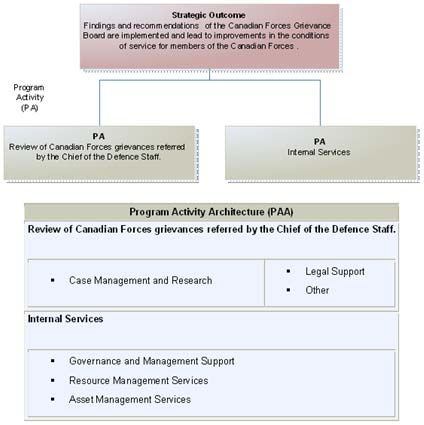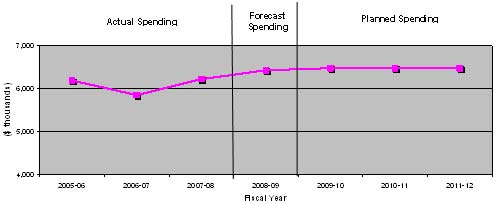Common menu bar links
Breadcrumb Trail
ARCHIVED - Canadian Forces Grievance Board
 This page has been archived.
This page has been archived.
Archived Content
Information identified as archived on the Web is for reference, research or recordkeeping purposes. It has not been altered or updated after the date of archiving. Web pages that are archived on the Web are not subject to the Government of Canada Web Standards. As per the Communications Policy of the Government of Canada, you can request alternate formats on the "Contact Us" page.
Chairperson's Message
 As Acting Chairperson, I am pleased to submit to you the Report on Plans and Priorities for the Canadian Forces Grievance Board (CFGB) for the period 2009-10 to 2011-12.
As Acting Chairperson, I am pleased to submit to you the Report on Plans and Priorities for the Canadian Forces Grievance Board (CFGB) for the period 2009-10 to 2011-12.
The Board adds to the adjudicative fairness of the grievance process by conducting objective and transparent reviews of grievances. As well, its mandate and quasi-judicial powers place it in an ideal position to identify systemic problems and bring them to the attention of the Canadian Forces (CF) leadership. The Board's value-added as an external body, independent from the chain of
command, is well established and is evident from the quality of its Findings and Recommendations and from feedback received from stakeholders.
During the coming year, we will continue our discussions with senior CF officials to improve the military grievance process at the Final Authority level. We will also continue to advance the case for expanding the Board's mandate so that all CF members who wish to grieve have access to an independent review of their grievances. The Board currently examines approximately 40% of the
files received at the Final Authority Level.
We also intend to continue reaching out to stakeholders. Complaints can be indicators of broader issues and may offer useful information to prevent problems or to improve policies or procedures. Through new publications aimed at both the CF leadership and CF members, the Board will continue to share valuable lessons learned from the grievance review process and to disseminate
information on the impact of its work and the value-added it brings to the grievance system.
The Board will also continue to monitor rigorously the efficiency of its operations and the quality of its Findings and Recommendations. More specifically, the Board will ensure the review of all files meets the standard of six months and will continue to assess its internal grievance review process, on a regular basis. These efforts will be supported by sound management initiatives and activities.
Building on the experience and maturity gained since the Board's inception in 2000, we will continue in the coming year to work towards achieving the highest quality and efficiency, in the best interest of justice and fairness.
Section I – Board's Overview
Raison d’être and Responsibilities
Mission
To review grievances, in order to render fair and impartial findings and recommendations in a timely and informal manner to the Chief of the Defence Staff (CDS) and the grievor.
The Grievance Context
The concept of military personnel having the right to grieve and receive redress is not new. Canada's introduction, in the year 2000, of an extra-military component to the Canadian Forces (CF) grievance system represented a major innovation in the handling of military grievances. That innovation was the creation of the Canadian Forces Grievance Board (CFGB).
As stipulated in the National Defence Act (NDA) and Chapter 7.12 of the Queen's Regulations and Orders for the Canadian Forces (QR&O), the Board's mandate is to review those categories of military grievances referred to it by the CDS. Following its review, the Board submits its Findings and Recommendations (F&Rs) to the CDS, simultaneously forwarding a copy to the grievor. It is the CDS, however, who is the final adjudicator on the grievance.
Chapter 7.12 of the QR&O sets out the types of grievances that can be referred to the Board. Specifically:
(1) The Chief of the Defence Staff shall refer to the Grievance Board any grievance relating to the following matters:
- Administrative action resulting in the forfeiture of, or deductions from, pay and allowances, reversion to a lower rank or release from the Canadian Forces;
- Application or interpretation of Canadian Forces policies relating to expression of personal opinions, political activities and candidature for office, civil employment, conflict of interest and post-employment compliance measures, harassment or racist conduct;
- Pay, allowances and other financial benefits; and
- Entitlement to medical care or dental treatment.
(2) The Chief of the Defence Staff shall refer every grievance concerning a decision or an act of the Chief of the Defence Staff in respect of a particular officer or non-commissioned member to the Grievance Board for its Findings and Recommendations.
Section 29.12 of the NDA stipulates that the CDS may also refer any other grievance to the Board.
Strategic Outcome and Program Activity Architecture (PAA)
Strategic Outcome: Findings and Recommendations of the Canadian Forces Grievance Board are implemented and lead to improved conditions of service for members of the Canadian Forces.
Program Activity Architecture
Planning Summary
| Financial Resources | 2008-09 | 2009-10 | 2010-11 |
|---|---|---|---|
| ($ thousands) | 6,458 | 6,458 | 6,458 |
| Human Resources | 2008-09 | 2009-10 | 2010-11 |
|---|---|---|---|
| Full-Time Equivalent (FTEs) | 46 | 46 | 46 |
* Includes Board Members appointed by Governor in Council.
| Expected Result Better understanding and application of regulations, policies and guidelines governing the conditions of work in the CF. * Success regarding this performance indicator will be assessed through formal evaluations every 5 years |
% of systemic recommendations that merit further study.* Target: 75% of recommendations that merit further study are accepted. |
| % of CDS agreement with the Board's recommendations regarding interpretation and application of regulations, policies and guidelines.* Target: 80% agreement |
|
| % of survey respondents indicating that the Board has contributed to changes to CF regulations, policies and procedures.* Target: 70% agreement |
| Program Activity | Forecast Spending 2008-09 |
Planned Spending ($ thousands) | |||
|---|---|---|---|---|---|
| 2009-10 | 2010-11 | 2011-12 | |||
| Review of CF grievances referred by the Chief of the Defence Staff (CDS) | 3,354 | 3,382 | 3,382 | 3,382 | Government Affairs |
| Internal Services | 3,082 | 3,076 | 3,076 | 3,076 | Government Affairs |
| Total Planned Spending | 6,436 | 6,458 | 6,458 | 6,458 | |
Contribution of Priorities to Strategic Outcome
| Operational Priorities | Type | Links to Strategic Outcome(s) | Description |
|---|---|---|---|
| Operational Performance – Maintain steady state productivity and excellence. | Ongoing | Findings and Recommendations of the CFGB are implemented and lead to improved conditions of service for members of the CF. | Why is this a priority? - Maintaining the high quality and timeliness of the Board's findings and recommendations. - Ongoing contribution to the transparency and efficiency of the grievance system for CF members. Plans for meeting the priority. - Conduct a program evaluation of the CFGB to study its goals and impacts. - Monitor the CF follow-up to CFGB Recommendations referred for further study/action by the CDS. |
| External Communications – Demonstrate the value-added of the CFGB in the grievance process. | Ongoing | Findings and Recommendations of the CFGB are implemented and lead to improved conditions of service for members of the CF. | Why is this a priority? - Building awareness of the Board's mandate and an understanding of the service it provides to the CF and the impact of its work, through reaching out to clients and stakeholders. - Learning from and sharing information, through exchanges with members of the military, stakeholders and target audiences. - Collaborating with other partners for the development of tools in order to monitor and communicate on the grievance system as a whole. Plans for meeting the priority. - Pursue discussions regarding the expansion of the CFGB mandate so that all grievances from CF members would benefit from an external review, independent of the chain of command. - Participation of the Board in the review of the National Defence Act (NDA) Bill C-25. - Conduct a program evaluation of the CFGB to study its goals and impacts. |
| Management Priorities | Type | Links to Strategic Outcome(s) | Description |
|---|---|---|---|
| Operational Performance – Ensure the overall effective management and leadership of the CFGB. | Ongoing | Findings and Recommendations of the CFGB are implemented and lead to improved conditions of service for members of the CF. | Why is this a priority? - Reinforce the importance of management excellence and sound internal oversight. Plans for meeting the priority. - The Board will focus its efforts to ensure a diverse, representative, capable workplace and workforce to deliver on the Board's mandate. - The Board has developed a formal risk management framework. Key elements of the framework will be implemented by the Board. - Further enhance the integration of planning and reporting instruments, including business and human resources planning. - Continuing focus on the development and implementation of knowledge and information management strategies. |
Risk Analysis
The achievement of some of the Board's key outcomes and priorities established for the planning period could be influenced by factors beyond the direct control of the Board. There are two important elements related to operational performance that are outside of the Board's control. The first significant factor is that the Board has no control over the number of grievances referred in any given year. Significant, unanticipated fluctuations in the volume of cases referred could have an impact on the timeliness of issuing Findings and Recommendations. To mitigate this risk the Board monitors workload planning assumptions on an ongoing basis and works closely with partners within the CF to base these assumptions on the most up-to-date information possible.
The second major factor that could have an impact on the Board's capacity to issue Findings and Recommendations on grievances is the timely appointment of Board Members by the Governor in Council. The Board mitigates this risk through ongoing liaison with the authorities within National Defence to ensure up-to-date communication of the Board's workload requirements.
The Board meets the challenge to justify its raison d'être by ensuring that grievors and leadership within the CF are aware of the value-added that the Board provides in its Findings and Recommendations.
Complaints can be indicators of broad or systemic issues that may offer useful information to prevent problems or to improve policies or procedures. The Board will continue to provide this information to leadership within the CF and to follow-up on the outcomes of discussions within the CF that result from the Board's Findings and Recommendations. The Board expects that participation in the review of the National Defence Act and conducting the CFGB five year progam evaluation within the planning period will give the Board another opportunity to emphasize its importance to the grievance process.
The recognition of the benefits of the Board's Findings and Recommendations also supports the efforts to expand the Board's mandate so that all grievors have the same access to an independent, external review. This would bolster confidence in the CF grievance process as a whole and contribute to the morale of CF members.
The Board faces several key human resources and information management and informatics challenges in the coming year. Some of these challenges, common to the Public Service, include changing demographics, projected labour shortages, effective labour relations and evolving learning needs. To ensure that the Board meets these challenges and to strengthen its human resource management, the Board has developed a comprehensive three-year strategic plan. As well, the Board has made it a management priority to ensure that the integrity and completeness of information within the organization is not compromised or lost.
Expenditure Profile
For 2009-10 fiscal year, the Board plans to spend $6.458 million to meet the expected results of its program activities and contribute to its strategic outcome.
Spending Trend
The decrease in actual spending in 2006-07 was due to a surplus resulting from staff turnover.
Voted and Statutory
This table illustrates the items displayed in the Main Estimates.
| Vote # or Statutory Item (S) | Truncated Vote or Statutory Wording | Main Estimates ($ thousands) |
Main Estimates ($ thousands) |
|---|---|---|---|
| 15 | Program expenditures | 5,864 | 5,897 |
| (S) | Contributions to employee benefit plans | 572 | 561 |
| Total | 6,436 | 6,458 | |


